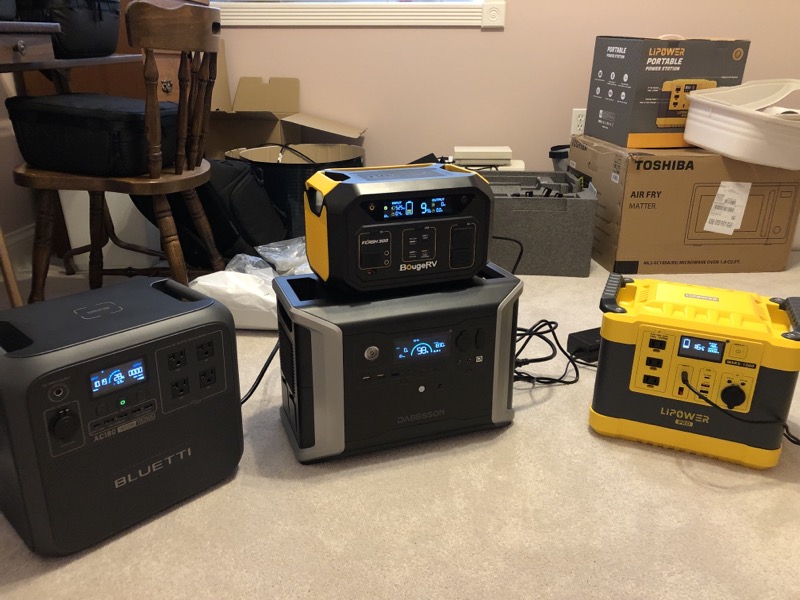
REVIEW – I finally got an opportunity to evaluate one of the big guys, in this case the Dabbsson DBS2300 Portable Power Station. Outfitted with a 2,330 Wh battery and a 2,200 W AC inverter, capable of operating at 3,000 W when operating with resistive loads. In addition, the unit can have its battery capacity expanded with up to two external 3 kWh batteries. I did not have access to one of the extended batteries to test this optional feature, however that did not stop me from eagerly checking out this large portable power station.
What is it?
The Dabbsson DBS2300 Portable Power Station is one of the larger, “portable” solar power stations equipped with a 2,330 Wh battery, with battery expansion capabilities up to 8,330 Wh, coupled to a 2,200 W AC inverter along with extensive DC circuits.
What’s in the box?
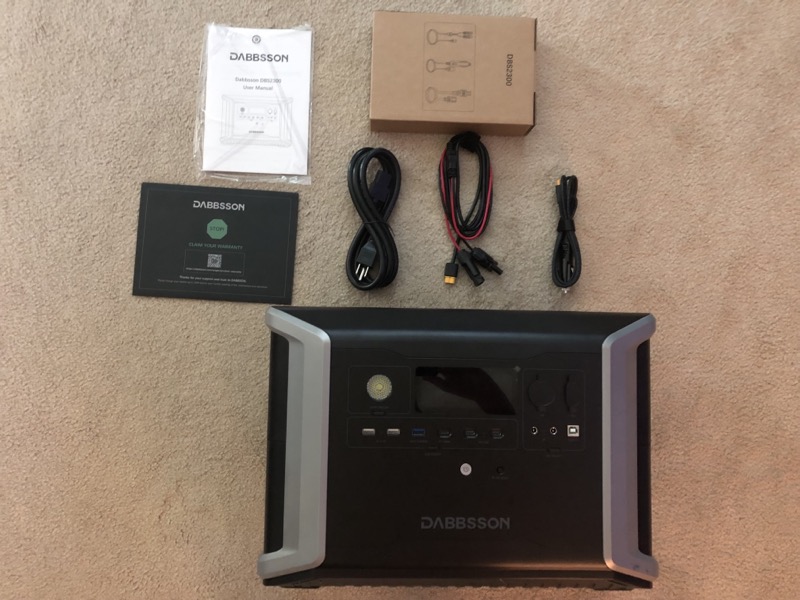
- Dabbsson DBS2300 Portable Power Station
- Solar Charging Cable
- AC Charging Cable
- Car Charging Cable
- Warranty Card/Warning Card/User Manual
Hardware specs
- Capacity – 2,330 Wh
- Battery Type – EV Semi-solid State LiFePO4 (4500 cycles to 80%)
- Communication – WiFi & Bluetooth
- AC Output – 2 (5) 2200 W (3000 W with P-boost), 4400 W Surge
- USB Output
- USBA – 1 fast charge 5V/3A, 9V/2A, 12V/1.5A 18W max
- USBA – 2 5V/2.4A 12W Max per port, 12W Max
- USBC – 1 PD 5/9/12/15V @ 3A, 20V @5A 100W max
- USBC – 2 PD 5/9/12/15/20V @ 1.5A, 30W max / port
- Car Charger – 6V @ 10A 126W max
- Anderson Output – 12.6V 30A DC, 378 W Max
- DC5521 Output – 2 12.6V @ 4A, 50.4 W Max Per Port
- AC Charge – 1800W Max
- Solar Input – 12-60V @ 12A (25A) max 600 W max
- Car Charging – 12/24 V @ 10A (8A)
- UPS – 15 ms switching time
- Dimensions – 17 x 10.01 x 11.94 in
- Weight – 53 lb
It should be noted that there are a couple of conflicts between what is in the manual specifications table, which the above was taken from, and the specifications parenthetically mentioned throughout the manual. I have marked the instances which appear in conflict in red.
Design and features
I am going to start with by far the least impressive feature of the Dabbsson DBS2300 Portable Power Station, but one you might need in a power outage or emergency situation is the front light so I will get that out of the way right now. The front light can be controlled by either continuous pushes of the button on the front of the unit, or the Dabbsson App. The light has three modes, dim, bright, and SOS. The SOS mode is an actual SOS signal via the light’s sequence (••• – – – •••), ie not just a blinking light. I would imagine that this light could operate for a very long time given the size of the battery that is powering it. 🙂
Now onto the meat of the Dabbsson DBS2300 Portable Power Station. The Dabbsson DBS2300, as the name implies, is equipped with a 2.33 kWh next generation battery based on industry standard EV semi-solid state LiFePO4 chemistry that provides 4,500 charge cycles before the battery capacity drops below 80%. Couple that larger battery with a 2.2 kW, 4.4 kW peak inverter, along with the ability to power up to 3 kW of purely resistive loads, this power station should be able to power anything in your house that plugs into a standard 120V 60 Hz outlet for a very long time. For those interested the unit can also generate power at 50 Hz should that be required.
While the AC specifications are significant, the DC specifications are even better. Much better than the two other 1 kWh devices that I have reviewed. Not counting the USB support, which is plentiful, albeit minus a wireless charging pad, there are four distinct DC circuits providing 12 Volts. Starting with support for the standard car adapter at 126W (10 A), 2 DC5521 ports each capable of supporting 50 Watts (4A), and a whopping 378 Watts (30 A) for the Anderson output. This later output is powerful enough to power many 12 V appliances as well as some of the new 12 VDC RV refrigerators that are on the market. While the DC outputs are located on the front of the unit, the AC outputs are located on the side of the unit.
Each output’s circuitry, AC, DC, and USB can be selectively turned on and off by their respective button under each output type. Each output section button also serves as an on/off indicator.
The Dabbsson DBS2300 Portable Power Station, when paired with the Dabbsson phone App unlocks additional flexibility in controlling some of the features of the unit. This includes the turning on and off of the three different outputs, AC, DC and USB, and also a more detailed look at the individual output rates, all the way down to each USB port.
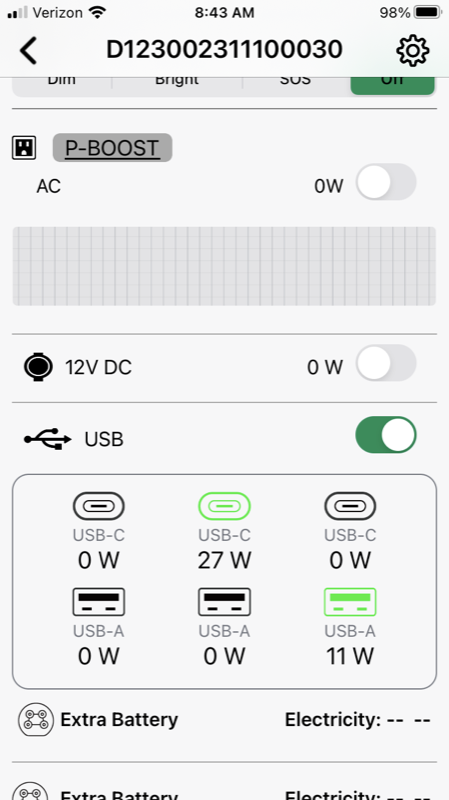
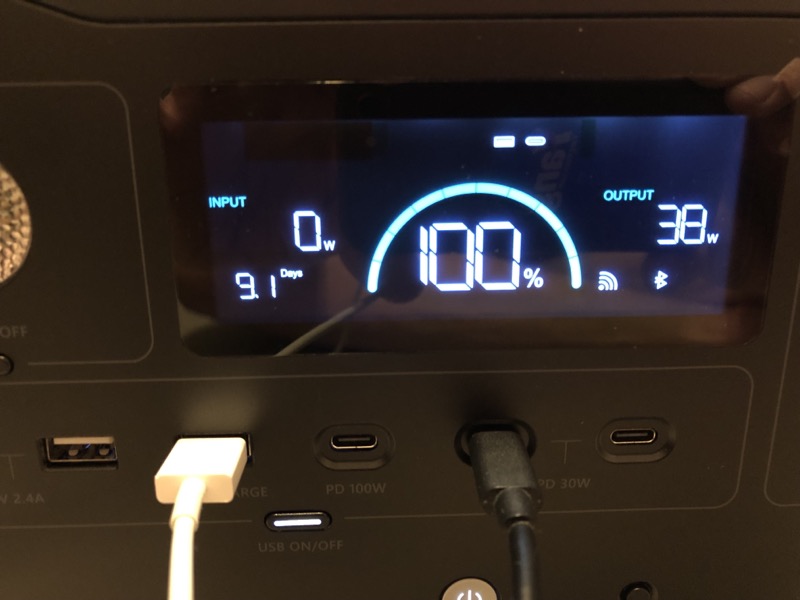
Once the setup is done, discussed below, one can interact with the unit from anywhere where there is internet access, assuming the unit is of course located where it too has access to the internet, typically one’s home internet, or possibly some kind of always on hotspot if used in a mobile application. Note that multiple devices can be controlled with this single App.
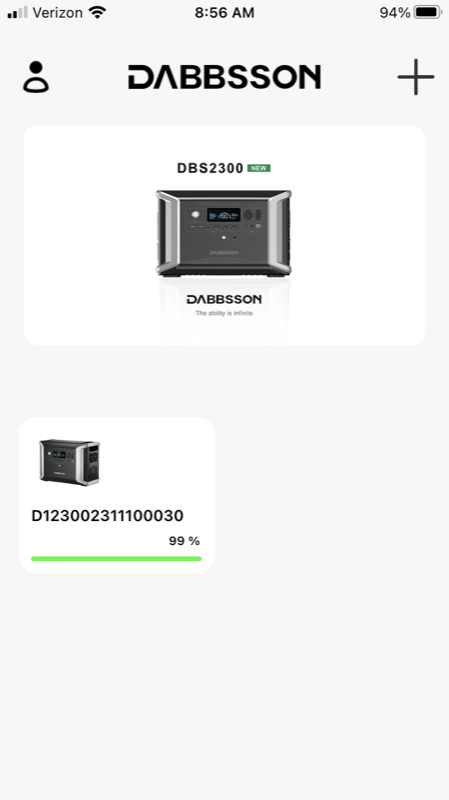 The display of the Dabbsson DBS2300 Portable Power Station is a very informative, multicolor display. Some of those icons are tiny but are discernible just fine if close enough to the unit. Not only does it include the power in and out, but it also shows the estimated time, either to charge full, or discharge, depending on the current power draw, or input charge value, or overall combination of both. One thing I really liked about the display is that it can be configured to be always on. Even though I can see everything with the App. I really like being able to see the display without having to physically hit a button on the front of the unit to wake the display up.
The display of the Dabbsson DBS2300 Portable Power Station is a very informative, multicolor display. Some of those icons are tiny but are discernible just fine if close enough to the unit. Not only does it include the power in and out, but it also shows the estimated time, either to charge full, or discharge, depending on the current power draw, or input charge value, or overall combination of both. One thing I really liked about the display is that it can be configured to be always on. Even though I can see everything with the App. I really like being able to see the display without having to physically hit a button on the front of the unit to wake the display up.
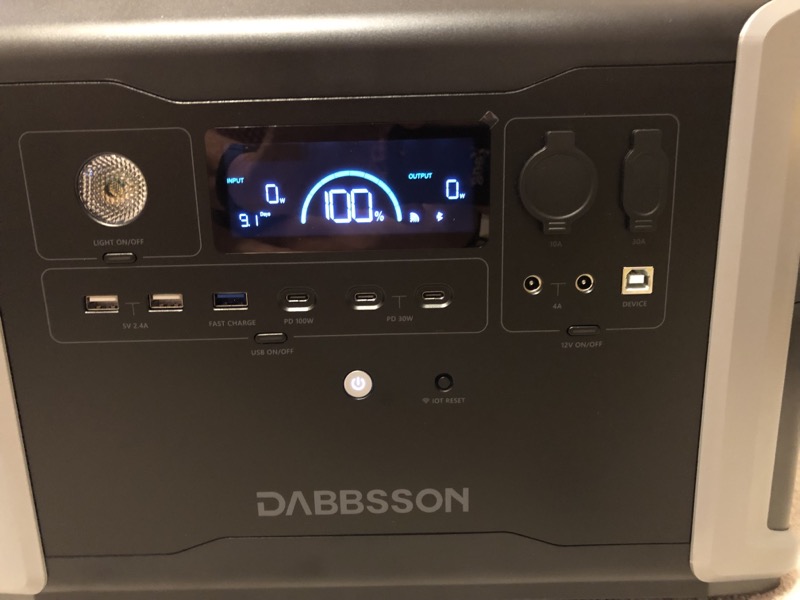
The Dabbsson App interface, while a little clunky in places, does convey all the information, as well as providing the essential controls to control the operation of the power station from afar via the internet as mentioned earlier. I say a little clunky because the App upon wake-up, i.e., the bringing from the background to the foreground, either from device sleep, or an App switch, the App display does not always reflect the exact current state of the Dabbsson’s battery SOC (State of Charge), and can take a couple of seconds, maybe 5ish or more to update. Honestly, it is not that bad, but one should be aware that if they just front the App they may be instantly greeted with older values, long enough in my opinion for one to assume they are up to date, when in fact, they will update a couple of seconds later. In addition, I did find some areas in the settings screen where the selected value is not reflected in the top-level settings screen. The AC input charging power is one such item. Again this is not true for all the settings but is for some. Note that this could be fixed by the time you read this review.
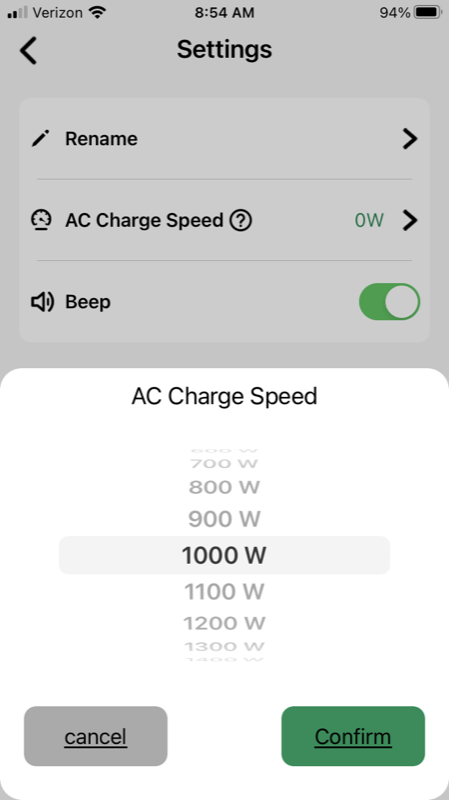
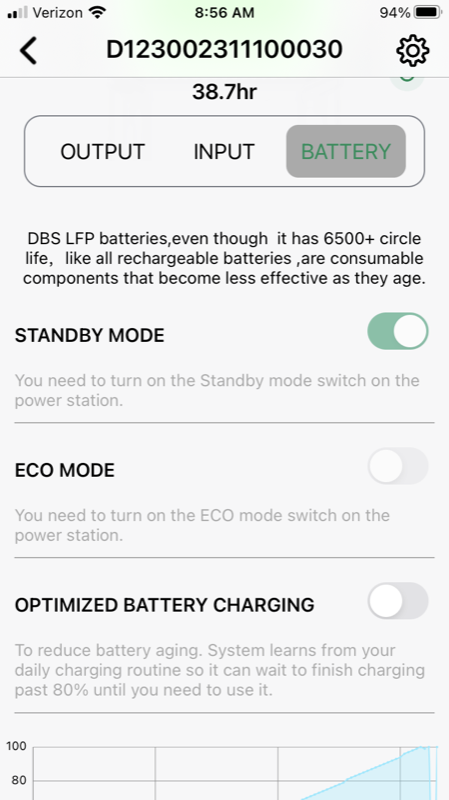
One other thing to mention about the Dabbsson App is that it will send the user a notification when the SOC reaches 5%. I thought this was a valuable notification.
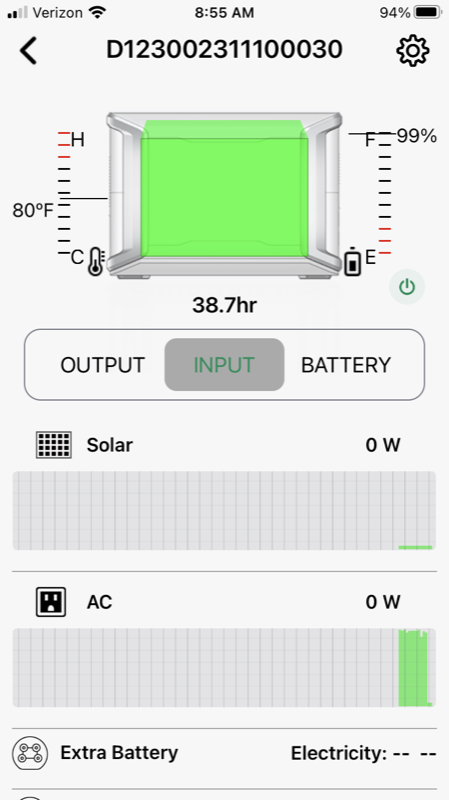
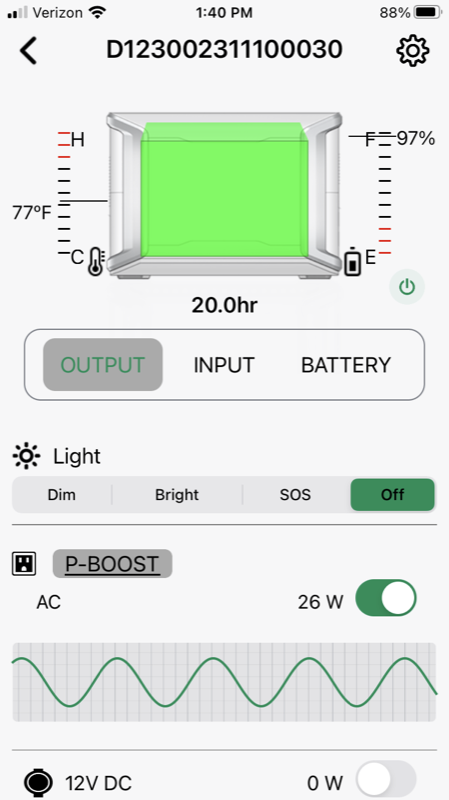
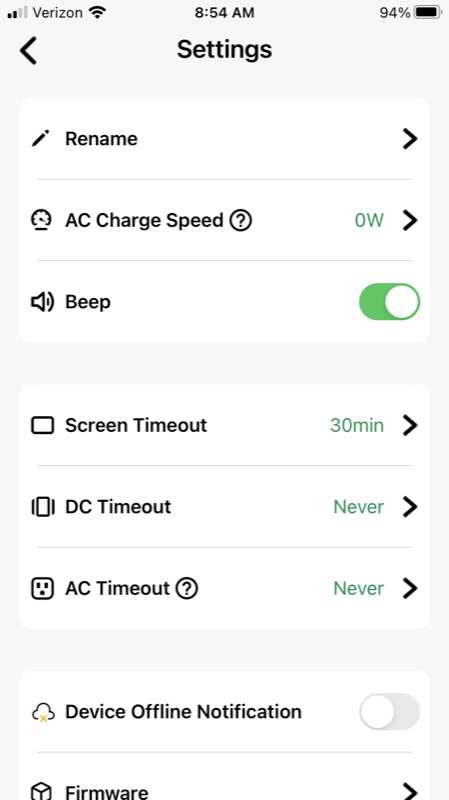
Another major feature of the Dabbsson DBS2300 Portable Power Station is the ability to have its battery storage expanded almost 4X. Now unfortunately I did not get to test this out as I was only shipped the actual power station, but this power station has the ability to be hooked up to two 3 kWh expansion batteries (DBS3000B), increasing the power station’s capacity from its original 2.33 kWh rating all the way up to 8.33 kWh! As one would expect, this comes with a higher price and at the time of this writing, each battery expansion is priced at $1,700 ($3,299 for one expansion battery, and $4,999 for two with the DBS2300) depending on the bundling deal of the day. The battery expansions are not only just batteries but also include solar charge controllers which allow the 8.33 kWh system to accept a total of 3 kW of solar charge, distributed between both expansion batteries @ 1.2 kW for each battery and 600 W to the DBS2300 portable power station. So it is important to note that it appears that each component manages its own solar charge input, compared to some systems where a master station would manage the charging of everything that is connected to it. I am speculating this as there is no mention of how to charge the external batteries in the manual for the actual power station. The DBS2300’s AC Fast Charging (1.8 kW) circuitry will also recharge any attached external batteries.
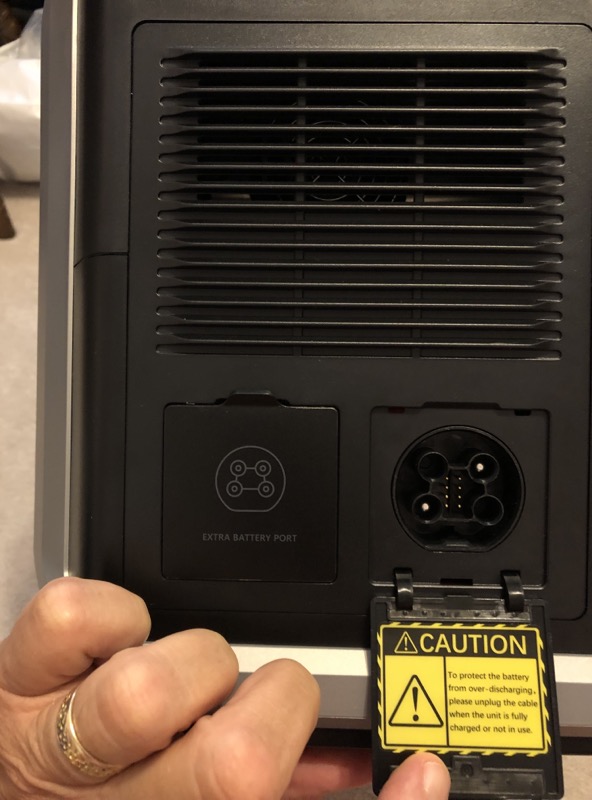
The max solar electrical inputs are rated at 60 volts DC and 25 amps, not to exceed 600 Watts total. Given the size of the battery, it would theoretically take 4 hours of perfect uninterrupted sunshine at 600 Watts to fully charge this device. Of course, this is not really achievable in a real-world situation, so expect the typical full solar charging of this device to take even longer. Dabbsson sells a really nice looking, based on the website’s picture, portable 200-Watt solar panel (DBS200S). I would recommend a minimum of two, really three, of these to have any chance of getting a complete charge in a day with optimum sun in the peak of summer if that is the only way to recharge the unit. Note one would need even more solar to recharge an 8.33 kWh extended system.
Like all of these systems, the best way to re-charge the Dabbsson DBS2300 Portable Power Station is still by utilizing the 1.8 kW AC fast-charging feature which can recharge the device in under 2 hours. While the Dabbsson DBS2300 Portable Power Station does ship with a DC car charging cable, it is limited to 96 Watts, and, well you do the math. I would say don’t leave home with the device mostly discharged, expecting your 10-hour car drive to your destination to bring the unit to even 50% SOC. Since the SOC of the device does not change the unit’s weight, just charge it before you hit the road if you intend to use it immediately at your final destination. All of the AC inputs to the system are located on the side of the unit, covered by a flap, which you kind of have to fight a little, right above the AC outputs.
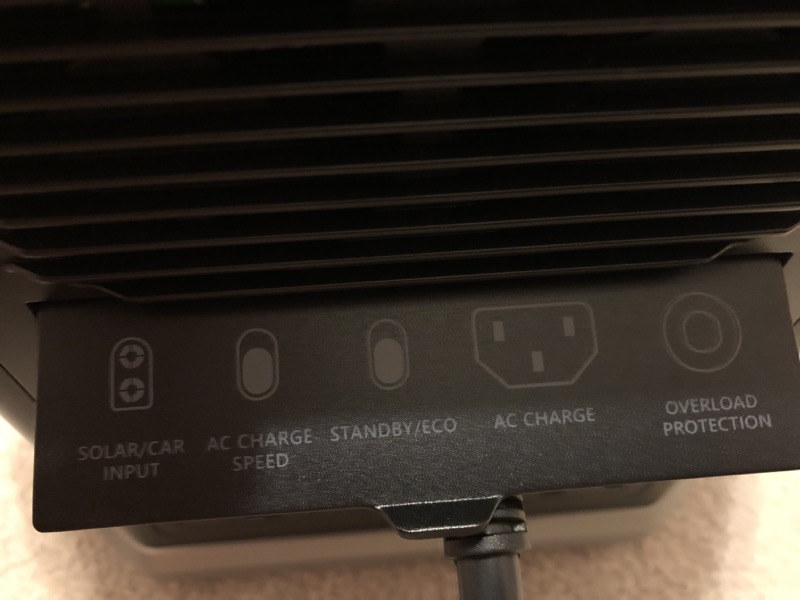
There are two manual switches, located under the input flap on the side of the unit.
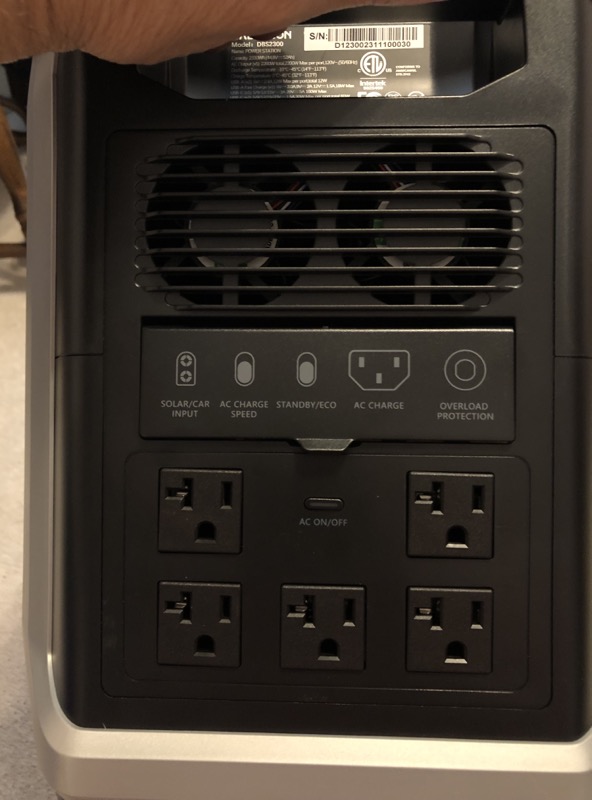
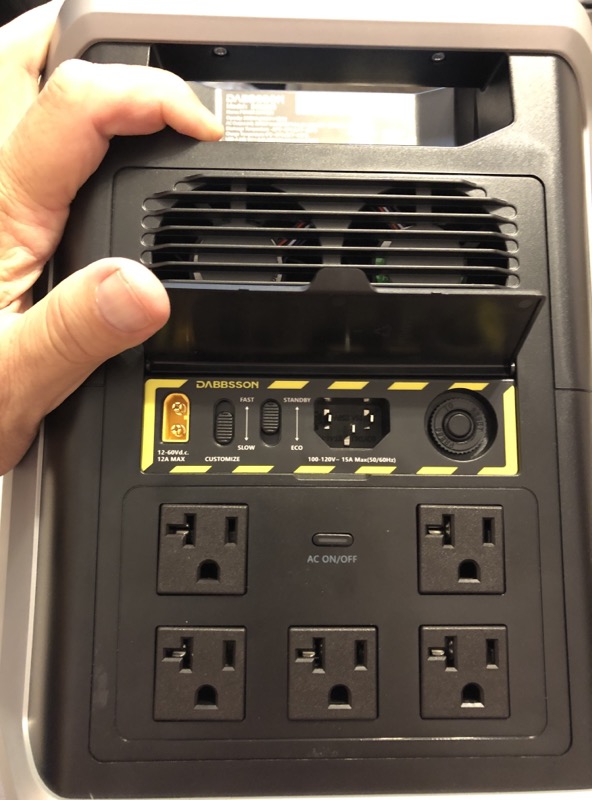
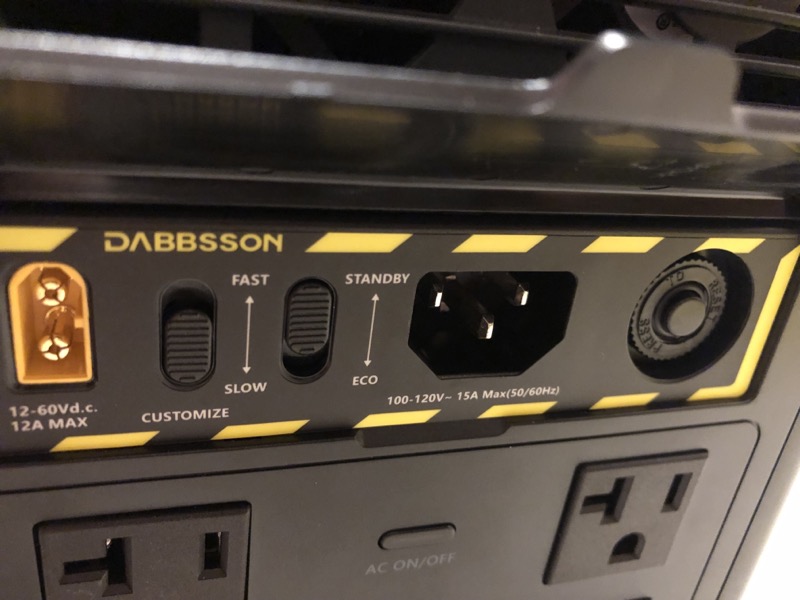
The first switch is the AC Charge Speed switch. This switch is a high-level control of the amount of power fed to the battery charging circuits from an AC charging source. When the switch is set to Slow (slid down), the user has the ability to adjust the AC charging rate in 200-Watt increments from 200-Watts all the way up to 1.8-kWatts via the App. If set to Fast (slid up), the power station will AC charge at the highest rate of 1.8 kW, and override any setting that is set in the App. In the end, this capability gives the unit an immense amount of flexibility for AC charging, and I think is a very good design decision. While being able to AC charge at 1.8 kW sounds cool, one may not be able to do that if one has other loads plugged into the same house circuit, and might not be aware.
The second switch, named ECO/Standby gives the Dabbsson DBS2300 Portable Power Station the capability to shut parts of itself down if there are no loads on a given output. Both the AC and DC circuits can be independently configured to shut down should there be no load for the selected amount of time. This is configured by having the ECO/Standby switch in the Standby (slid up) position, with the individual configurations accomplished by using the App to specify the actual timeouts before the circuit being configured is shut off. In the case of the DC circuits, the user can select one of .5/1/2/6/12 hours, or never, and for the AC circuits, the user can select one of 2/4/6/12/24 hours or never. This feature is very important for this power station as explained in more detail below. Positioning the ECO/Standby switch in ECO mode will ignore any App settings, and the unit will shut down completely if no activity occurs on any input for two hours.
Finally, the Dabbsson DBS2300 Portable Power Station has UPS (Uninterruptable Power Supply) capabilities, Dabbsson calls this feature EPS (Emergency Power Supply), with a specified 15 millisecond switching time. I think this UPS capability is just awesome as the station remains charged, providing back-up power when needed should power be lost. I did my standard test, which since I only have laptops is based on a TV and cable box. I plugged in a TV and cable box into a power station which was plugged into a standard wall AC outlet, turned everything on, and then removed the AC power from the power station. As expected, I could not notice a difference. Like most of these power stations, the documentation states that a test should be run to determine if the switching time is sufficient to support the mission that the device is being used for.
Setup
My unit arrived in a brown box, with no handles to aid in moving it around. At 53 pounds the Dabbsson DBS2300 Portable Power Station is not light, and the first thing I did was to open the box, exposing two nice handles on each side of the device so I could move it to a more convenient location.
Guided by the user manual I downloaded the Dabbsson App from the Apple App Store onto my iPhone 8, running iOS 16, to begin the setup of the device with the aid of the manual. I had a little difficulty with this in the beginning, thinking it was on my end as I could not get the device to attach to my phone’s hotspot. More research revealed that the iPhone 8 only has a 5 GHz hotspot, while newer iPhones (12 and later) have the capability of generating the 2.4 GHz band which is required to work with the DBS2300. The manual does a good job of including screenshots for each step so I will not duplicate any of those here. In the end, I got everything up and running with my home internet connection and everything works just fine. Here is a link to Dabbsson’s introduction video which explains the setup much better than the reading of a paragraph could ever do.
Performance
So how did the Dabbsson DBS2300 Portable Power Station perform? Well, that is a little complicated.
Like most of these portable power stations, you turn on the unit and then independently control each output type. As mentioned earlier, this unit has three such controls, one for AC, one for DC, and one for USB.
I will start with what it did best. From a full charge, the Dabbsson DBS2300 Portable Power Station powered two 900-Watt (1,800-Watt total) space heaters for an hour, which according to the equation on their website, 2,330Wh*0.85/1,800 equates to 1.1 hours. I ran it for a little over 1 hour, and there still was 4% SOC left when I shut it down, so while I may have been just a couple of minutes short, I think overall, it was pretty accurate. I was very impressed. That said, the fan is quite loud in my opinion during this, and at other times doing various tasks.
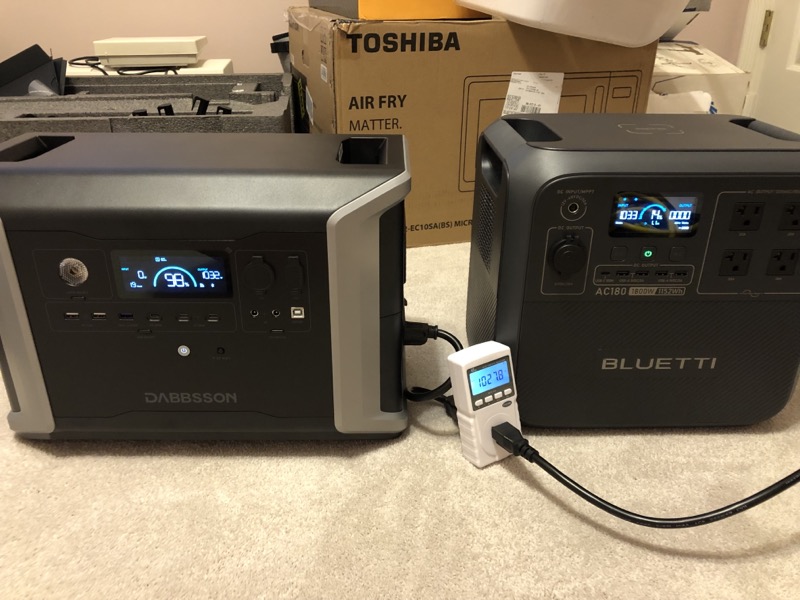
During the process of discovering the above equation, I ran across this little tidbit on the website. (Note: Not suitable for devices < 400W output, for our product’s inverter will affect the run time.) This little note would turn out to explain a lot.
I initially noticed some underperforming using the same TV entertainment setup that I have used in the past for all the previous systems. In short, I have my 55” TV, cable box, Apple TV, Bose sound bar, all plugged into an APC UPS, which was plugged into the Dabbsson DBS2300 Portable Power Station. In this mode, depending on what was going on, the power draw would vary from 30 to 100 Watts. Since I had recently reviewed a Bluetti 180AC, which has a battery size of only 1,152 Wh, slightly less than half of the Dabbsson’s battery size, I had a baked in expectation of how long I thought this would run. In short, I was expecting the Dabbsson power station to run the setup about two times longer. At the completion of the test when I measured that it was nowhere close to two times longer, I was quite disappointed. Instead of consuming something close to 1480 Wh (two times the half sized Bluetti’s 740 Wh) it ran down after consuming only 870 Wh as measured with an external Watt meter.
After the inverter finding mentioned above, the next thing I thought to do was to engage first the AC and then the DC systems, with no loads. Configuring the ECO/Standby settings to never shut down and was further astonished by just how poorly this power station performed with no load attached. In both cases the Bluetti AC180 seriously outperformed this unit with its ECO/Standby settings turned off independently for both the AC and DC circuits. Briefly, the Dabbsson unit ran for about 48 hours with no AC load with the unit configured to never turn off. If one does a little math, it seems that the inverter consumes almost 50 Watts in that standby mode. For comparison, the Bluetti had about 50% of its battery left at that time, with only half of the battery.
It is worth pointing out that doing the same test with just the DC configured to never turn off with no load, the unit performed much better, 4.75 days (114 hours) but again fell far short of the half sized Bluetti, which lasted another week, and still had 11% charge left.
After I discovered the < 400 Watt inverter Dabbsson note mentioned above, I relaxed my expectations some since it was clear that this unit was just not designed to do what my test case did, so it would be unfair to be too harsh with the power station, given the test was poorly designed for this unit. The problem was, what test would be a good one for this unit? If one hooks up a large load, like the two heaters described above, the unit will power down quickly as one would expect, and if it is connected to light loads, it will power down much quicker than one would expect.

So I decided to do a little more testing and I decided to use the Dabbsson Portable DBS2300 Power Station to charge not only the Bluetti 1.152 kWh (32% SOC) system at 1000 W, but also a smaller 300 Wh system at 600 Watts (0% SOC), and another 1.2kWh (0% SOC) system at only 200 W since it does not have fast charging AC circuitry. To be fair, the total kWh to be charged exceeded the battery size of the Dabbsoon unit with 100% efficiency, so there was no expectation that I could restore the three other units to 100%, but I gave it a shot anyway. If you do the math, one would think the Dabbsson would have little trouble charging all three at the same time. At the start of the test, the Dabbsson system jumped up to 1800 W, charging all three systems at the same time with ease. As expected, the 300 Wh system charged up first, followed shortly after by the fast charging Bluetti, leaving the slower charging 1.2 kWh device with about a 16% SOC. The Dabbsson was spent with 48% SOC in the 1.2 kWh device. As mentioned earlier, it was not really possible for the Dabbsson to charge all three, with the starting SOCs for each device mentioned above. So, I started another test with just the two larger units, both with 30% SOCs to see if the Dabbsson would be able to charge both to full. According to my estimates, it was doable, and at the end of the test, I had two large units fully charged, and 5% SOC left on the Dabbsson. I think both of these were pretty good tests of just how powerful the Dabbsson DBS2300 Portable Power Station unit is. It likes heavy loads and really excels in that kind of situation. The inefficiency of the inverter really does not come into play unless the unit is powering small AC loads for an extended period of time. The last test made me feel much better about the capabilities of the Dabbsson power station.
I did a brief 3 kW load trial by enabling the pboost feature of the AC circuit via the Dabbsson App and using the same two space heaters, operating at 1500 Watts vs 900 as in the earlier test. The Dabbsson DBS2300 Portable Power Station powered both without issue. When operating in this expanded power mode the Dabbsson, like the Bluetti, lowers the supplied voltage, as evidenced by monitoring the wattage meter, to achieve this simulated increased power support. With purely resistive modes, this is not a big deal, and while I am certain the connected space heaters are not providing their maximum rated output, they are able to run without damage, which is why this mode of operation is provided.
Finally, given the 4.4 kW surge capability of the inverter, I thought I would have no trouble running a large (14,000 BTU) stand-alone room air conditioner which runs on a standard 120V plug and was disappointed when the air conditioning unit overloaded the system when the compressor engaged. I must assume the surge from this large air conditioner exceeded 4.4 kW, something I just did not think would occur.
What I like
- Comprehensive Informative Display
- Comprehensive Informative Display and Control from the App.
- Good DC circuit Support
- Extendable Battery Storage Design
What I’d change
- The flap over the inputs is just kind of annoying.
- Clean up some of the App interface bugs.
- More efficient performance in low AC wattage situations
Final thoughts
The more I played with and thought about the Dabbsson DBS2300 Portable Power Station, the more I liked it. I really started to get the feeling the DBS2300 would be really great for a Van build based solely on its 12 VDC capabilities. Turns out the battery extensions, provide even more DC circuit outputs (each unit providing another high wattage 12 V circuit, and a 24 V circuit). None of the other units that I have tested are even close to providing as much DC support as the DBS2300 power station does. If you throw in the very impressive 2.2 kW AC support, then the DBS2300 should be able to power anything one would need on a weekend campout. Couple that with the ability to solar charge the unit at 600 W and the ability to fast charge at 1.8 kW, the increased recharge cycles afforded by the DBS2300’s EV semi-solid State LiFePO4 battery chemistry, it should provide the user with years of expandable portable mobile power. The only thing I would recommend is to turn off any unused output sections of the unit, specifically the AC section if nothing is going to be connected to it.
Price: $1,599.00
Where to buy: Dabbsson.com and Amazon (there’s currently a $400 instant coupon)
Source: The sample of this product was provided by Dabbsson.



Gadgeteer Comment Policy - Please read before commenting
Live in South Florida. Hurricanes can result in no electric from FPL for days or more. Would this system run my home refrigerator and a couple of lights.
I’ve lived through several hurricanes with the use of a gas powered generator. Gas is expense and often hard to get. Generators are not always reliable, try in the middle of a storm having to remove clean and reinstall the carburator of one at 3 a.m.
I read today (11/26) in the Miami Herald about an 800 watt solar array that would charge the system in three hours. (Page 5C)
With the added extra battery would this system support the limited use of power (refrigerator and a couple of lights) considering for three hours a day there apparently would be no power while charging. Or would the charging at all times during daylight keep it running 24 hours.
I read the a roof top solar array plus backup of storage batteries would keep the whole house going 24/7. the cost would be probably 3 or 4 times that of Dabbsson with extra battery or two and the solar array. the State of Florida offers some assistance and I would also save on electric bills. My house is a small (1000 sf) free standing. My big power use is 3 ton central air conditioner that I could do without during power outages. Electric averages about $200.00 per month.
Your review was detailed and apparently well researched except of course my questions above or my inability to understand application to my question.
I would appreciate your response particularly if it is good news to my question.
Richard,
Lots to unpack here. I will try to address your questions below.
Would the Dabbsson run your refrigerator and a couple of lights? It sure would. Without knowing more about your fridge and the lights you are attempting to run, there is not much more I can say about that. I have an old fridge which requires around 300 Watts to run. Doing the simple math, and ignoring the draw of the inverter, it seems like it would run for 6 hours, continuously, which of course, refrigerators (cold ones) do not do. If it only required a 50% duty cycle, that would turn into 12 hours. Adding that extra battery sure seems like it would run for 24 hours+ given the expanded batter is significantly larger than the built in battery.
Unfortunately I could not get to the Miami Herald reference that you mentioned. The Dabbsson unit is limited to only 600 Watts max of solar input. Adding one of the additional batteries expands that to 1.8 kWatts with 1.2 kWatts being hooked directly in to the extra battery. Keep in mind that how much solar input one gets from solar cells is dependent on some things that are out of your control like clouds for instance. In addition, you must continuously re-position them for maximum output to get close to those rated values.
With respect to a whole house solution, you can check out this video where a situation is described. https://www.youtube.com/watch?v=DA3fRMm3a0c&t=1s While the link is very Tesla specific, the thought process is the same regardless of the solar / battery back up system. You start thinking in kWatts and kWatt/hours, the former is a measure for solar panel output (as well as inverter power output) and the later is a measure of how much a battery can store.
There is so much that one has to look at which directly influences the costs. Solar array size, battery back up capacity, even installation if you are talking a whole home solution.
I hope this helps.